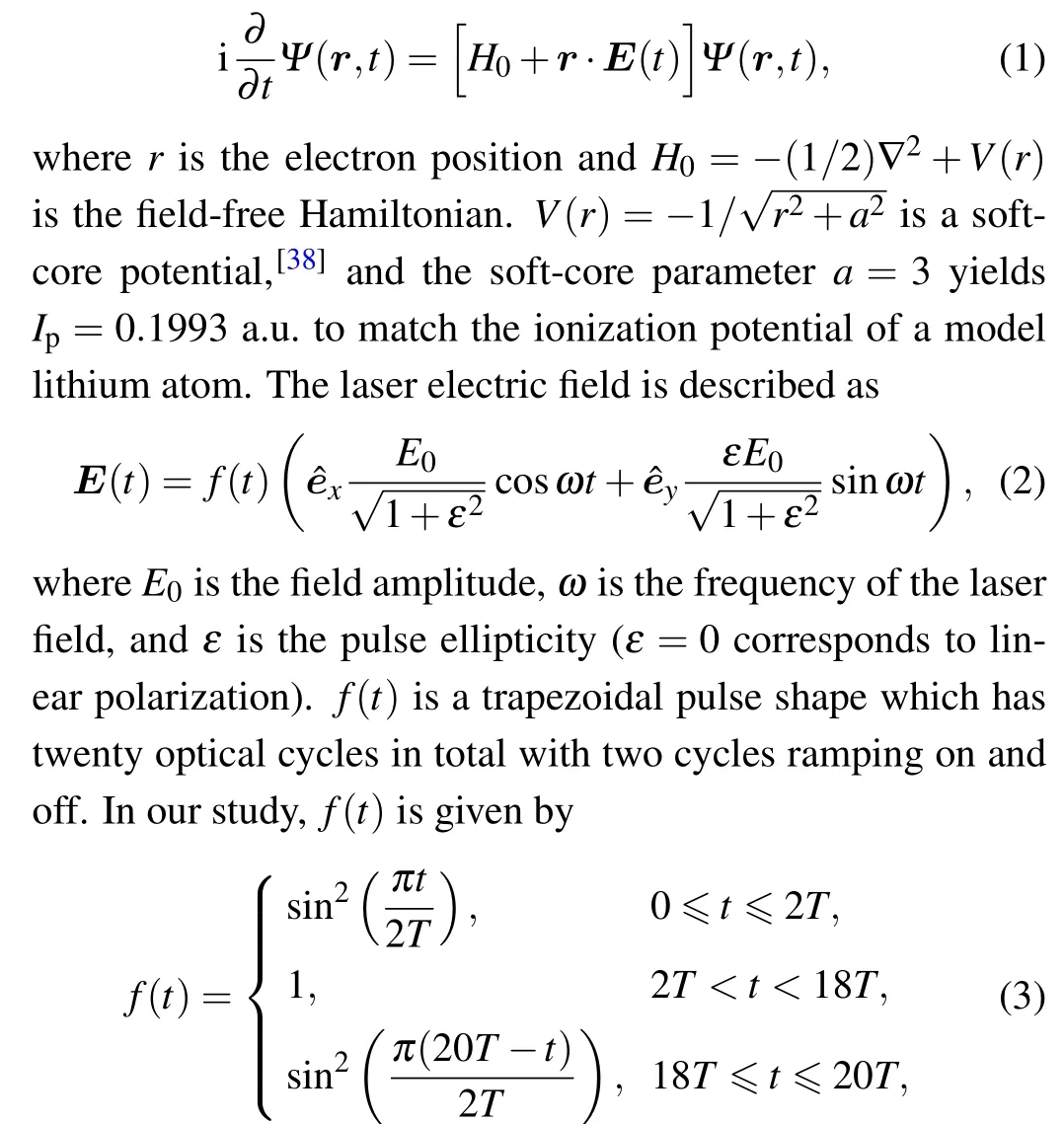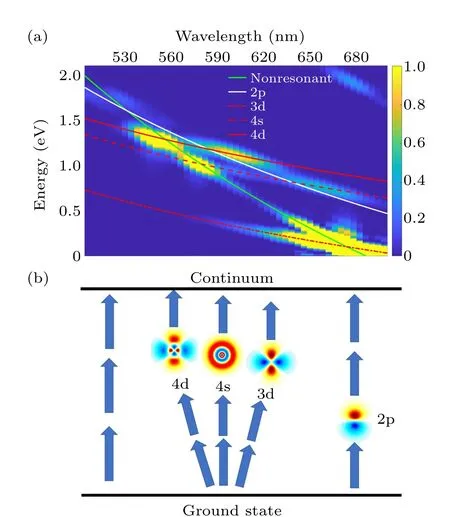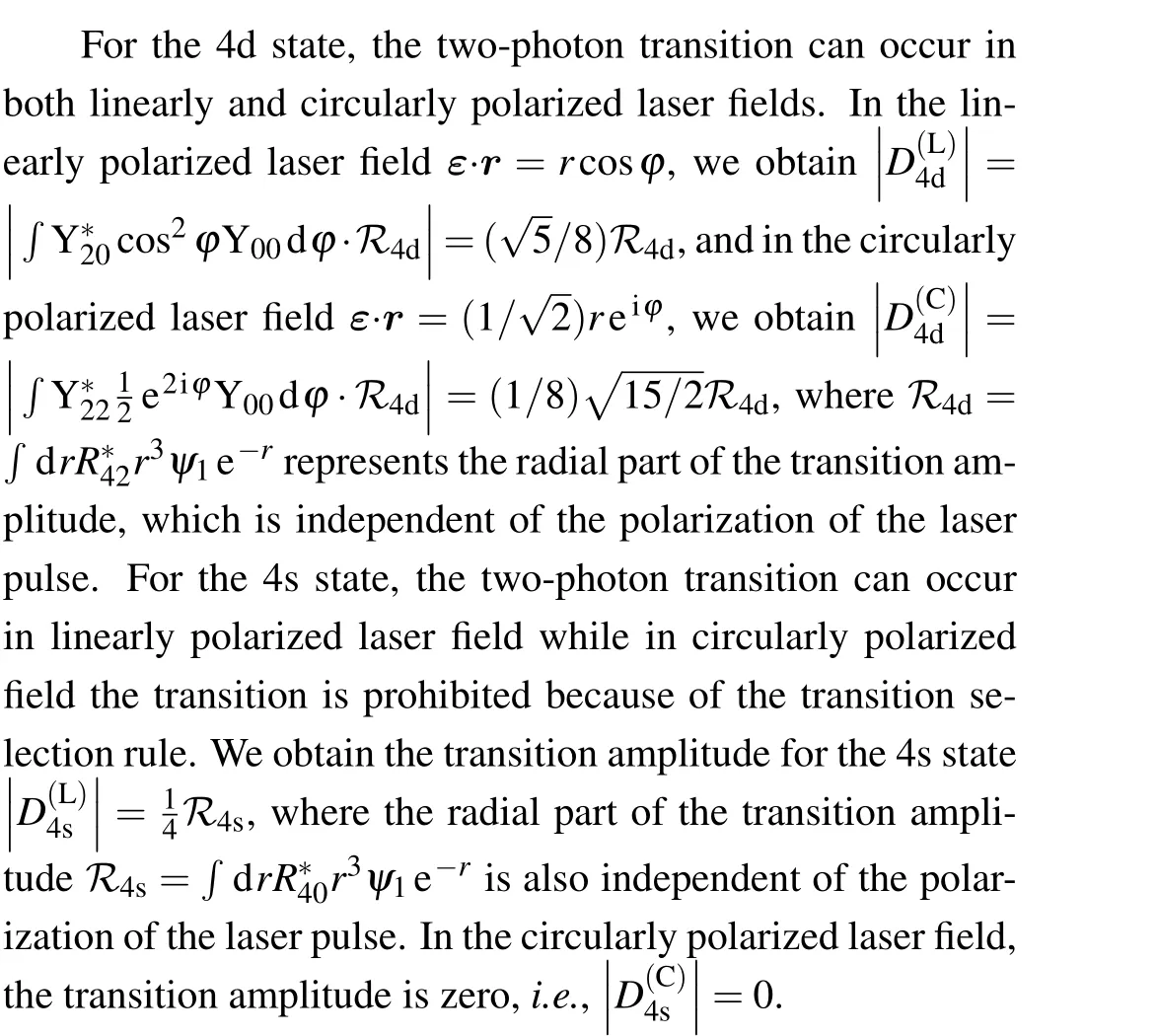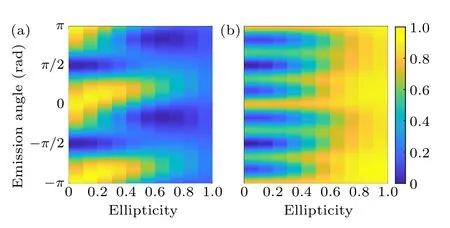Wavelength-and ellipticity-dependent photoelectron spectra from multiphoton ionization of atoms
2023-03-13KeyuGuo郭珂雨MinLi黎敏JintaiLiang梁锦台ChuanpengCao曹传鹏YuemingZhou周月明andPeixiangLu陆培祥
Keyu Guo(郭珂雨) Min Li(黎敏) Jintai Liang(梁锦台) Chuanpeng Cao(曹传鹏)Yueming Zhou(周月明) and Peixiang Lu((陆培祥)
1School of Physics and Wuhan National Laboratory for Optoelectronics,Huazhong University of Science and Technology,Wuhan 430074,China
2Optics Valley Laboratory,Wuhan 430074,China
Keywords: multiphoton ionization,ultrafast phenomena,Freeman resonance
1.Introduction
Multiphoton ionization(MPI)of atoms and molecules attracted great attention in the past few decades.[1-4]Nowadays,advances in high-power short-pulse laser technologies make it possible to observe many interesting effects in the MPI process, such as laser-intensity dependence of the photoelectron yield,[5]Rabi-flopping effect,[6]and circular dichroism.[7-9]A range of important applications such as laser-induced plasma generation,[10,11]chemical diagnostics,[12,13]molecular structure imaging,[14,15]electron vortices generation,[16]and photoelectron spectroscopy[17]can be implemented through the MPI.
In the MPI process,the photoelectron can be released via either resonant or nonresonant ionization pathways.For the nonresonant ionization, the photoelectron is released directly from the ground state of the atom.On the other hand, when the resonance occurs, the atom is ionized via an intermediate excited state,revealing many fine structures for the low-energy above-threshold ionization peaks in the photoelectron energy spectra.This phenomenon is dubbed Freeman resonance,[18]which can be attributed to ac-Stark shift of the energy level of the excited states of atoms in the laser field.Separation of the resonant and nonresonant ionization signals from the photoelectron spectra is of great significance for investigating many ultrafast processes, such as the inner-shell ionization dynamics,[19]resonant ionization time delay,[20,21]and fine structure threshold effects.[22]Since the shift of the excited state energy level and the ionization threshold depends on the laser intensity by the ac-Stark shiftUp=Ilaser/4ω2withUpbeing the ponderomotive energy,ωbeing the frequency of the laser field, andIlaserbeing the laser intensity, the nonresonant peaks in the photoelectron energy spectra shift towards lower energy as the laser intensity increases while the Freeman resonant peaks do not shift with the laser intensity.Thus by simply scanning the laser intensity,the nonresonant and resonant ionization pathways can be identified and isolated from the intensity-dependent photoelectron energy spectra.[23-25]
Most of previous works about the MPI concentrated on rare gas atoms.[26]For those atoms, the laser field strength corresponding to the MPI regime is far lower than the threshold laser field strength of over-the-barrier ionization (OBI)regime, which is estimated asEOBI=I2p/4 (Ref.[27]) withIpbeing the ionization potential of atoms.For atoms with relatively lower ionization potential, such as Li, Na, K, and Rb atoms,the threshold laser intensity of the OBI regime is about 1012W/cm2.[28,29]At this laser intensity,the atom is severely ionized and the electron is mainly released during the leading edge of the laser pulse.[30]For the laser intensity below the OBI threshold,Upbecomes very small(smaller than 0.03 eV at a typical laser wavelength of 800 nm).[31]Thus both nonresonant and resonant peaks in the photoelectron energy spectra are nearly unchanged with the laser intensity due to the negligible ac-Stark shift.Moreover, those atoms with relatively low ionization potentials usually have several excited states with similar energy levels complicating the MPI process[32-34](i.e.,the different intermediate states can be reached through a small detuning by absorbing the same number and frequency of photons).Therefore, it is difficult to identify the resonant and nonresonant ionization pathways by scanning the intensity of the laser pulse for those atoms.
In this paper,we study the MPI of a model lithium atom in a laser pulse over a wide range of wavelengths by numerically solving the time-dependent Schr¨odinger equation(TDSE).Previously,a number of consecutive channels switching effects were observed by changing the laser wavelength for rare gas atoms.[35-37]We find that the photoelectron momentum distribution (PMD) reveals many ring-like structures for the three-photon ionization of the model lithium atom which vary significantly with the laser wavelength.We show that several intermediate states can simultaneously be resonant with the laser field in the ionization process.Because the position of the nonresonant and resonant ionization peaks in the photoelectron spectrum is mainly determined by the number of absorbed photons from the intermediate (for resonant ionization) or ground (for nonresonant ionization) states to the continuum, the shift is different with the change of the laser wavelength for the resonant and nonresonant ionization pathways.Thus the wavelength-dependent photoelectron energy spectrum can be used to distinguish those different ionization pathways.Moreover,we also study the MPI for different laser ellipticities.We find an abnormal ellipticity dependence of the electron yield for the (2+1) resonance-enhanced ionization via the 4d intermediate state.
2.Theoretical methods
To obtain the time-dependent wave function of an atom in the laser field, we numerically solve the two-dimensional TDSE with the single-active-electron approximation in length gauge which is expressed as

whereTis the period of the laser pulse.At the end of the pulse,the wave function is further propagated for an additional ten optical cycles to ensure that all the ionized components move away from the core.[39]
In the numerical simulations,we set the peak intensity of the laser field to be 5×1011W/cm2,and the laser wavelength varies from 500 nm to 700 nm.The time step is set to be Δt=0.1 a.u.The cartesian grid space ranges from-600 a.u.to 600 a.u.for bothxandydirections with a spatial step of Δx=Δy=0.3 a.u.The TDSE is solved with a split-operator spectral method starting from the ground s state of the atom obtained by the imaginary-time propagation method.[40]It is worth mentioning that after the ground state wave function is obtained, the wave function of the first excited state can be obtained by removing the ground state wave function components at each step of the imaginary-time propagation.Similarly, the wave function of other bound states can also be obtained.
3.Results and discussion

In order to reveal the origin of those ring-like structures,we show the angle-integrated photoelectron energy spectrum as a function of the laser wavelength ranging from 500 nm to 700 nm, as shown in Fig.2.We can see many complex structures in the wavelength-dependent photoelectron energy spectrum.The ionization is enhanced for different electron energies at several wavelengths,i.e.,~1.4 eV at~550 nm,~1.2 eV at~570 nm,~1.3 eV at~590 nm, and nearthreshold electrons at~660 nm.

Fig.1.The PMDs from MPI in a linearly polarized laser field with various laser wavelengths of(a)λ =553 nm,(b)λ =573 nm,(c)λ =593 nm,and(d)λ =629 nm.

Fig.2.(a)The wavelength-dependent photoelectron energy spectrum in a linearly polarized laser field.The green solid line represents nonresonant ionization [n=3 in Eq.(4)], the white solid line represents the (1+2)resonant ionization via the 2p intermediate state[s=2 in Eq.(5)],and the red lines represent the(2+1)resonant ionization via the 3d, 4s, and 4d intermediate states[s=1 in Eq.(5)].(b)Different ionization pathways,i.e., nonresonant ionization(left),(2+1)resonant ionization via the 4d,4s, and 3d intermediate states (middle), and (1+2) resonant ionization via the 2p intermediate state(right).
To understand those structures in Fig.2(a),we analyze the dependence of the nonresonant and resonant ionization peaks in the energy spectrum on the laser wavelength.For the nonresonant ionization,the energy of the photoelectron can be described as
wherenis the number of photons that the atoms need to absorb from the ground state.Here we have ignored the effect of the ac-Stark shift becauseUpis relatively small(Upis smaller than 0.03 eV).For the resonant ionization, the energy of the photoelectron can be described as
wheresis the number of photons that the atoms need to absorb from the intermediate resonant state,andEiis the energy level of the intermediate resonant state.
The green solid line in Fig.2(a) shows the electron energy for the nonresonant ionization as a function of the laser wavelength [n=3 in Eq.(4)].One can see that the electron energy decreases rapidly with the increase of the wavelength.This nonresonant ionization pathway is illustrated in the left of Fig.2(b).For the resonant ionization, the energy levelsEiin Eq.(5) of different excited states are obtained by the imaginary-time propagation in TDSE.In Fig.2,we only show those intermediate states that are relevant to the wavelengthdependent photoelectron energy spectrum by comparing with the TDSE result,i.e., the (1+2) resonance-enhanced ionization via the 2p state (white dashed line) and the (2+1)resonance-enhanced ionization via the 3d, 4s, and 4d states(red dot-dashed,dotted,and solid lines).Those different ionization pathways are shown in Fig.2(b).One can see that the electron energy of the resonant ionization pathways decreases more slowly than that of the nonresonant ionization pathway with the increase of the wavelength.The slope for the curve of the(2+1)resonant ionization is smaller than that of(1+2)resonant ionization.This can be understood according to Eq.(5).The slope of the dependence of the electron energy on the laser wavelength(or frequency)is determined by the number of photons absorbed from the intermediate state to the continuum.The (2+1) resonant ionization absorbs one photon from the intermediate state to the continuum while the(1+2)resonant ionization need to absorb two photons.Thus the slope of the dependence of the electron energy on the laser wavelength is different.Moreover, we can also see that the ionization is enhanced at those regions when two lines are intersected.Those regions correspond to that the detuning of the resonance approaches zero,leading to the enhancement of the ionization.When the detuning increases, the ionization yield decreases rapidly.
According to those lines in Fig.2(a),we can identify the origin of different rings in Fig.1.In Fig.1(a),the ring structure comes from the(2+1)resonant ionization via the 4d state.Atλ=573 nm of Fig.1(b),the two rings atp~0.3 a.u.,0.27 a.u.,and 0.18 a.u.come from the(2+1)resonant ionization via the 4d,4s,and 3d states,respectively.Atλ=593 nm of Fig.1(c),the ring atp~0.3 a.u.comes from the resonant ionization via the 2p and 4d states.The two rings atp~0.27 a.u., and 0.18 a.u.are of the same origin as those in Fig.1(b).Another ring atp~0.24 a.u.comes from the nonresonant ionization.Atλ=629 nm,as shown in Fig.2(d),the ring atp~0.24 a.u.originates from the(2+1)resonant ionization via the 4s state.The other two rings atp~0.16 a.u., and 0.13 a.u.originate from the nonresonant ionization and the(2+1)resonant ionization via the 3d state, respectively.Thus the wavelengthdependent photoelectron energy spectrum allows us to identify the origin of those multiple ring structures in the PMD.
With identifying the ionization pathways from the wavelength-dependent photoelectron energy spectrum,we can further study the ionization dynamics for both resonant and nonresonant ionizations.Next, we mainly focus on the dependence of the photoelectron yield from the resonant ionization pathway on the laser ellipticity.We choose the case ofλ=573 nm for analysis because the photoelectron yield from resonant ionization via the 4s and 4d states is comparable.The angle-integrated photoelectron energy spectrum for the 4s and 4d states is shown as a function of the ellipticity of the laser field in Fig.3(a).We can see that the photoelectron yield from resonance-enhanced ionization via the 4s state decreases significantly with the increase of the ellipticity,whereas the yield from resonance-enhanced ionization via the 4d state increases with the increase of the ellipticity.To understand the abnormal ellipticity dependence of the electron yield for the resonant ionization via the 4d state,[41]we show in Fig.3(b) the normalized population of the 4s and 4d states at the end of the laser pulse from the TDSE result.As we can see, the population of the 4s state decreases while the population of the 4d state increases with the increase of the ellipticity.Thus the ellipticity dependence of the ionization yield comes from the population of the excited states.

Fig.3.(a) The ellipticity-dependent photoelectron energy spectrum at the laser wavelength of λ =573 nm.4s and 4d are used to indicate the intermediate states of the resonant ionization for the two most obvious peaks in the energy spectrum.(b)The normalized population at the end of the laser pulse of the 4s state(red line)and the 4d state(blue dotted line)as a function of the laser ellipticity according to the TDSE result.(c)The normalized transition probability from the ground state to the 4s state (red line) and the 4d state (blue dotted line) as a function of the ellipticity according to Eq.(7).
Next we investigate the excitation probability from the ground state and the excited state using the perturbation theory.For both 4s and 4d states,two photons are needed to absorb from the ground state.For such a two-photon absorption process, the transition amplitude from the initial ground state|g〉to the excited state|f〉with the dipole approximation can be given by[42,43]
whereεis the polarization vector along the polarization direction of the incident radiation field.Mis an auxiliary dimensionless operator, which can be written asM(r) =ψ1(r)ε·r,[42]whereψ1(r)is the separated function along the radial direction.The ground state and the excited state can be written asΦ(r)=Rnl(r)Ylm(θ,φ),whereRnl(r)is the radial wave function and Ylm(θ,φ) is the spherical harmonics.n,l, andmare the principal quantum number, angular quantum number,and magnetic quantum number,respectively.

For the elliptically polarized laser field in Eq.(2),we can treat it as the superposition of a circularly polarized laser field and a linearly polarized laser field,i.e.,
by neglecting the pulse envelope.Thus the relative contribution of the linearly and circularly polarized laser fields to the whole intensity of the elliptically polarized laser field can be written asa1= (1-ε)2/[2ε2+(1-ε)2] anda2=2ε2/[2ε2+(1-ε)2], respectively.The excitation probabilityσfrom the ground state to the excited state is proportional to|D|2and the intensity of the laser fieldI,[42]so the ratio of the excitation probability in the ellipticity polarized laser field with arbitrary ellipticity to that in the linearly polarized laser field can be written as,for the 4s and 4d states,respectively,
The normalized transition probability as a function of ellipticity is shown in Fig.3(c)for the 4s and 4d states according to Eq.(7).By comparing the curves in Figs.3(b) and 3(c), we find that the transition probability reveals the same trend with respect to the ellipticity as the population of the electron yield from the excited state from the TDSE result.Therefore the abnormal ellipticity dependence of the resonant ionization via the 4d intermediate state mainly comes from the effect of the excitation probability from the ground state to the 4d state.
We further study the dependence of the photoelectron angular distribution on the ellipticity for the (2+1) resonant ionization via the 4s and 4d states, as shown in Fig.4.For the (2+1) resonant ionization via the 4s state, as shown in Fig.4(a), the photoelectron angular distribution spectrum shows two maxima atε=0.The spectrum becomes isotropic with respect to the emission angle atε= 1.For the 4d state, as shown in Fig.4(b), the photoelectron angular distribution spectrum shows six maxima atε=0 and also becomes isotropic with respect to the emission angle atε=1.For relatively small ellipticity value ofε<0.5, we find that the most probable emission angle for the resonant ionization via the 4s state obviously shifts as a function of the laser ellipticity, while for the 4d state it barely shifts.For relatively large ellipticity value ofε>0.5, the ionization yield via the 4s state decreases rapiadly,while for the 4d state,the six-lobe ring structure keeps unchanged but the intensity of the angular distribution has an unobvious shift.The shifts of the angular distribution may result from the influence of the Coulomb potential.The energy of the photoelectron ionized via the 4s state is lower than that via the 4d state so that the Coulomb potential has a larger influence on the photoelectron ionized via the 4s state.Thus the angular distribution shift for the 4s state is more obvious.More specific explanations need further investigation.

Fig.4.The photoelectron angular distribution as a function of the laser ellipticity for the(2+1)resonant ionization via the intermediate states of(a)4s state and(b)4d state at the laser wavelength of λ =573 nm.
4.Conclusion
In conclusion, we have studied the dependence of the photoelectron spectra from three-photon ionization of an atom on the laser wavelength and ellipticity.By continuously changing the wavelength, we show that the wavelength dependence of the electron energy from the nonresonant and resonant pathways reveals different slopes, which is determined by the number of photons absorbed from the resonant(for resonant ionization)or ground(for nonresonant ionization)states to the continuum.Moreover, we find an abnormal ellipticity dependence for the(2+1)resonance-enhanced ionization via the 4d intermediate state,which can be attributed to the effect of the two-photon excitation probability from the ground state to the 4d state.In addition,we find that the angular distribution of the photoelectrons from the resonance-enhanced ionization might also be influenced by the excitation process from the ground state to the intermediate state.Our study enriches the understanding of the MPI process with several resonant states,and might stimulate experimental interests in coherent control of electron dynamics for those atoms or molecules with relatively low ionization potentials.
Acknowledgments
Project supported by National Key Research and Development Program of China (Grant No.2019YFA0308300)and the National Natural Science Foundation of China(Grant Nos.12021004 and 61475055).
杂志排行
Chinese Physics B的其它文章
- Matrix integrable fifth-order mKdV equations and their soliton solutions
- Comparison of differential evolution,particle swarm optimization,quantum-behaved particle swarm optimization,and quantum evolutionary algorithm for preparation of quantum states
- Explicit K-symplectic methods for nonseparable non-canonical Hamiltonian systems
- Molecular dynamics study of interactions between edge dislocation and irradiation-induced defects in Fe-10Ni-20Cr alloy
- Engineering topological state transfer in four-period Su-Schrieffer-Heeger chain
- Spontaneous emission of a moving atom in a waveguide of rectangular cross section
